Wazir Khan Mosque Lahore
When we consider the culturally diverse city of Lahore, sometimes known as the “Paris of the East,” Wazir Khan Mosque immediately comes to mind. This architectural masterpiece is located in the walled city of Lahore on the southern side of Shahi Guzargah, and the traditional route traveled by the Mughal royals to reach the Lahore fort.
Wazir Khan Mosque was commissioned by the ruler of Punjab, Hakeem Ilam-ud-din Ansari, who was the senior physician at the Mughal court. He became one of the most valued associates and aides of Emperor Shah Jahan after providing invaluable assistance to the prince during his early battles.
Due to this trust and Ilam-ud-din Ansari’s efforts, the emperor bestowed him with the title of Wazir Khan and allotted large land and property near the Delhi Gate.
Facts About the Wazir Khan Mosque
The mosque is an oasis of tranquillity in the heart of the bustling Walled City, surrounded by marketplaces, residences, and small shops that line the narrow cobblestone streets of the inner city.
When entering the 160 ft. x 130 ft. courtyard bathed in sunlight, guests encounter the magnificent structure. The courtyard is a haven of beauty, elegance, and tranquillity.
An essential element of the entrance area of the mosque is the Calligrapher’s Bazaar, which intersects the entrance axis at a right angle and is designated at this intersection by a huge verandah (dewhri) with a dome on top.
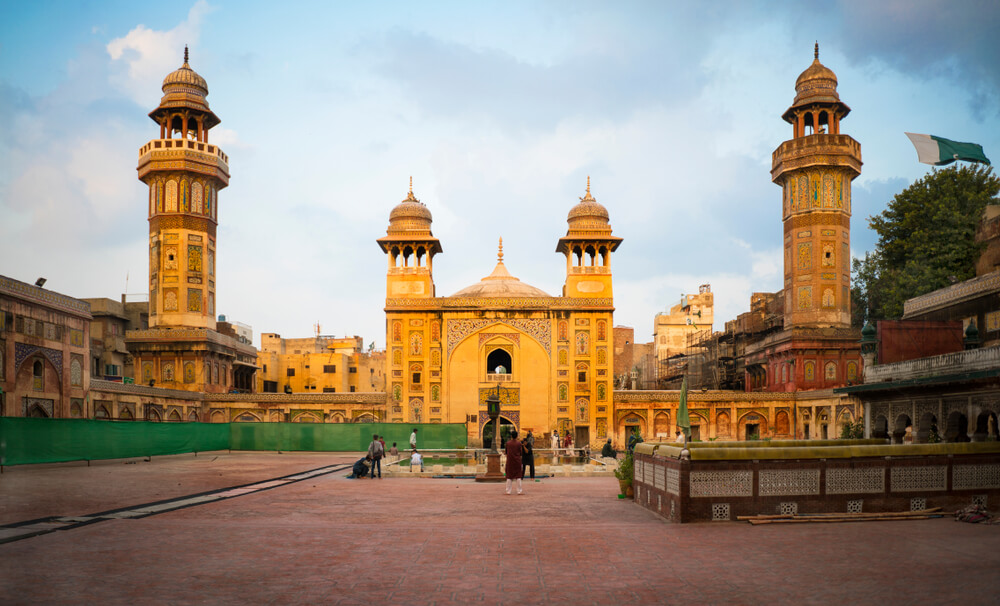
The royal trail may reach this monument on foot, also known as Shahi Guzargah. This path was named since the Mughals used it to travel from Delhi to Lahore Fort. You will observe this magnificent mosque standing eminently on the path leading toward Chowk Wazir Khan.
Before a few years ago, the monument was obscured by multiple encroachments and did not appear as it does today. In 2012, the Walled City of Lahore Authority demolished the encroachments and cleared the vista for the public and tourists.
History of Wazir Khan Mosque
It was constructed around the tomb of the saint Syed Mohammad Ishaq Gazrooni, also known as Miran Badrooni. In the thirteenth century, he emigrated from Iran and lived in Lahore during the Turkish-Muslim Tughlaq dynasty. The Wazir Khan Mosque was part of a more extensive complex that comprised a row of bazaars where calligraphers and bookbinders repaired holy texts and painted Quranic verses.
With time, however, the Calligrapher’s bazaar grew to include additional vendors selling spices and other goods. The profits from these markets were used to maintain the mosque. A hallmark of the Wazir Khan Mosque in Lahore is the presence of numerous stores surrounding the old mosque.
Construction commenced in 1634 A.D. Only a short distance from the Lahore Fort, the Wazir Khan Mosque is of tremendous significance because it was where Emperor Shahjehan offered Friday prayers.
Intriguingly, the Wazir Khan Mosque is accessible via the Royal Trail, a 1.6-kilometer road that begins from the Delhi Gate of the walled city of Lahore. Numerous Mughal Emperors rode horseback via Delhi Gate on their way to Lahore Fort.
The rectangular mosque from the Mughal era is around 282.7 x 165.4 feet and has four magnificent minarets that define the corners of the central courtyard. Let’s delve deeper into the design of the Wazir Khan Mosque.
The Architecture of The Wazir Khan Mosque
Under the Mughals, the mosque was a site of wisdom and learning where scholars of the highest level from around the Muslim world would congregate for scholarly discourses. In the past, students studying the Holy Quran and calligraphy resided in the mosque’s modest rooms (hujras).
Incredible is the mosque’s main entrance! The mosque’s main entrance is located on the eastern side and is accessed via a spectacular gateway that is a monument in itself.
During recent excavation and conservation work in the chowk, the facade and original ground level of the mosque were rebuilt, requiring tourists to climb even more stairs to enter. The main entrance projects two feet beyond the surrounding walls and is flanked on both sides by two-foot-diameter minarets topped with small domes.
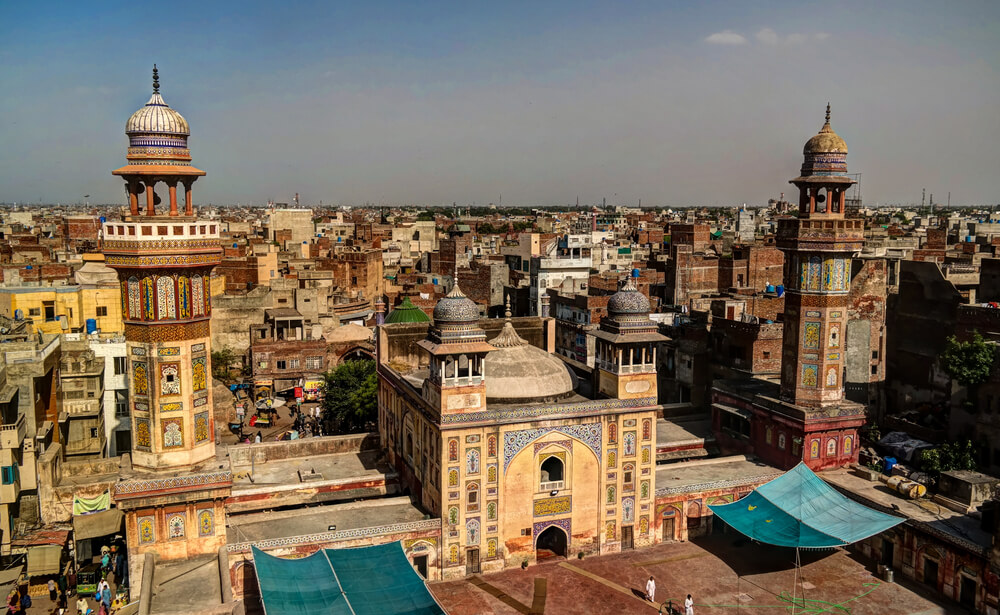
A second entrance to the market is located on the northern side of the mosque. The Aga Khan Trust for Culture and the Walled City of Lahore Authority have also recently conserved this wall and gate.
The arched niche at the mosque’s entrance facing the Wazir Khan Chowk is elaborately painted with floral themes. It contains one of Lahore’s earliest examples of a Muqarna — an architectural element is seen on the Alhambra in Spain and several imperial mosques in Iran.
According to architects and historians, the prayer hall’s low domes resemble the style of the Lodhi dynasty, which controlled Lahore before the Mughal era.
Wazir Khan Mosque Offers Various Attractions
Wazir khan Mosque offers a lot of attractions to its visitors. So, read on to find out!
Art and Design
The arched niche at the mosque’s entrance facing the Wazir Khan Chowk is elaborately painted with floral themes. It contains one of Lahore’s earliest examples of a Muqarna — an architectural element is seen on the Alhambra in Spain and several imperial mosques in Iran.
Most of the mosque is constructed of cut and prepared brick adorned with mosaics of glazed tile. You will observe that the exterior bricks of the mosque are intricately embellished with title work known as Kashi-Kari.
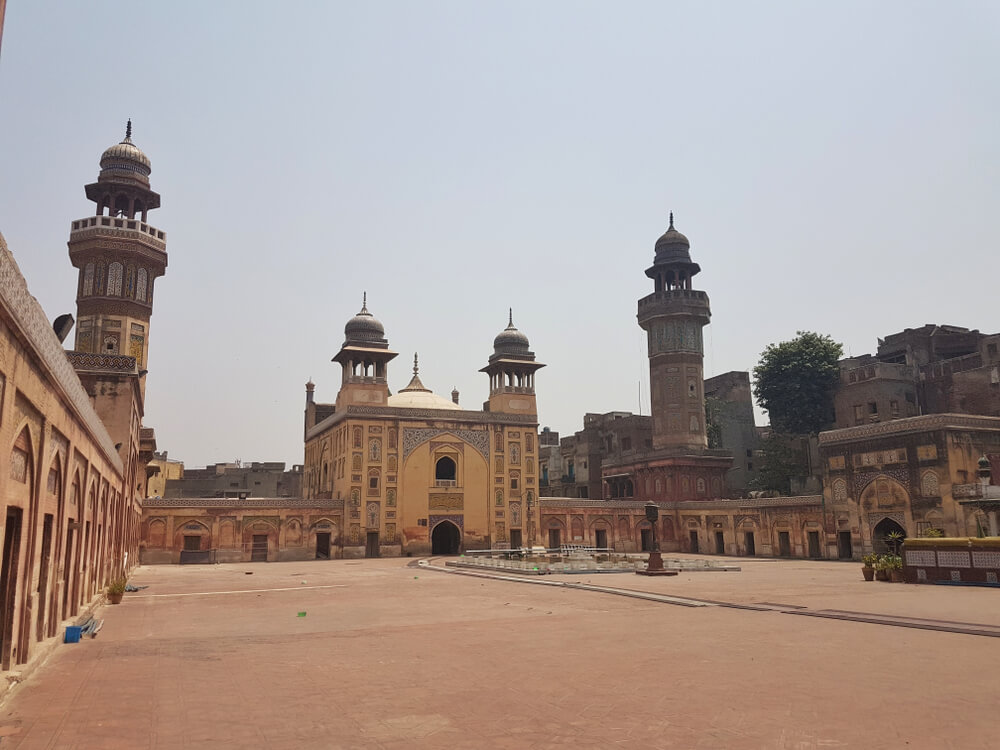
The facades facing the inner courtyard are adorned with motifs and a color palette that exhibit major influences from Persia throughout the 17th century. Persian-influenced designs include star-shaped flowers and grapes. These hues give the mosque a dynamic and lively appearance, and everybody who visits it will feel as if it is speaking to them through the colors.
Four Minarets
The mosque’s most striking feature is its four minarets, which stand magnificently at the four corners of the courtyard. Mughal architects and designers first adopted this concept in Lahore. From these minarets, the entire walled city is visible.
Prayer Hall
This mosque’s prayer hall is another architectural wonder. It is one of the most ornate prayer halls of Lahore’s Mughal-era mosques, and you will be awestruck by it. The entire room is covered in frescos and calligraphy.
These embellishments can be found inside the prayer hall and on the mosque’s front, minarets, and walls. The prayer hall follows the one-aisle, five-bay motif first developed in Lahore’s Maryam Zamani Mosque and ultimately found its full expression in Emperor Aurangzeb’s Badshahi Mosque, constructed half a century later.
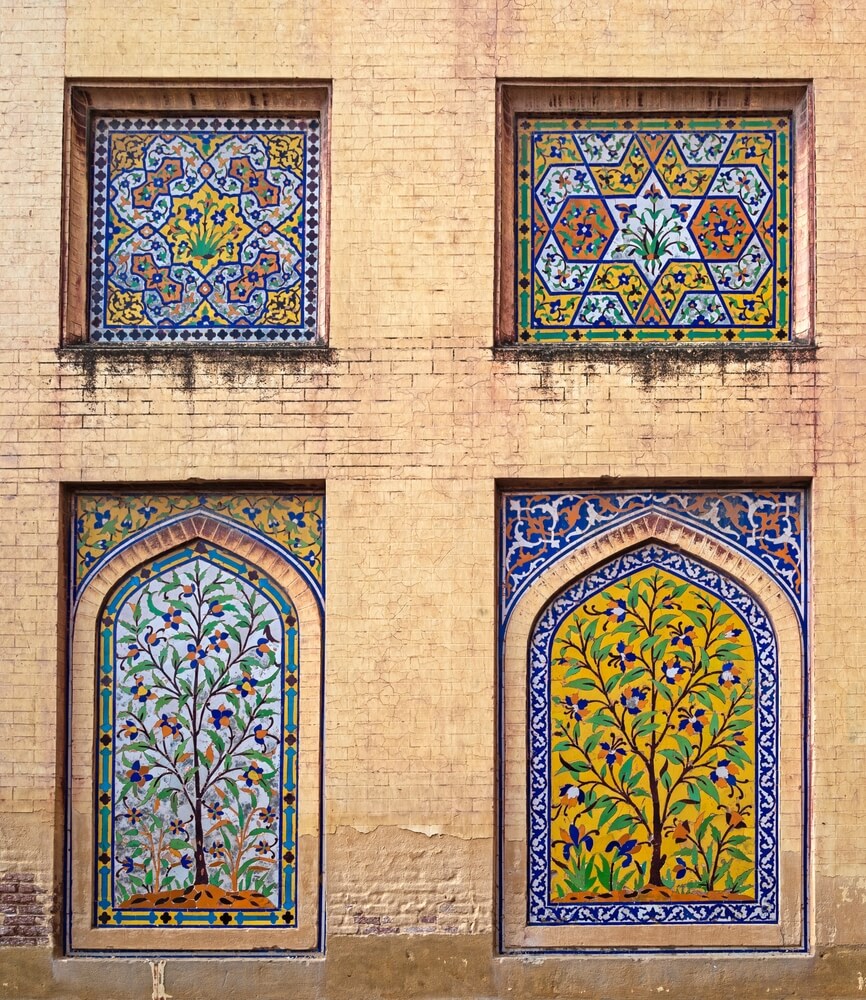
Most of the mosque is constructed of cut and prepared brick adorned with mosaics of glazed tile. You will observe that the exterior bricks of the mosque are intricately embellished with title work known as Kashi-Kari. The facades facing the inner courtyard are adorned with motifs and a color palette that exhibit major influences from Persia throughout the 17th century.
Persian-influenced designs include star-shaped flowers and grapes. These hues give the mosque a dynamic and lively appearance, and everybody who visits it will feel as if it is speaking to them through the colors.
The Calligrapher’s Market
An essential element of the entrance area of the mosque is the Calligrapher’s Bazaar, which intersects the entrance axis at a right angle and is designated at this intersection by a huge verandah (Dewhri) with a dome on top.
28 Hujras (Cubicles)
The courtyard is bordered on the north, south, and east by small chambers known as hujras. Thirty-two in total, thirteen on each of its northern and southern wings, six on its eastern side, and three on either side of the leading portal’s entry.
All hujras are rectangular; however, their dimensions vary. On the north and south side, the hujras are identical in size, except for a tiny difference in the north of hujras, each featuring a window that opens onto the bazaar on their northern sides. The ablution area, or Wadu area, is located in the courtyard. The azure, glistening water has a hypnotic effect on you.
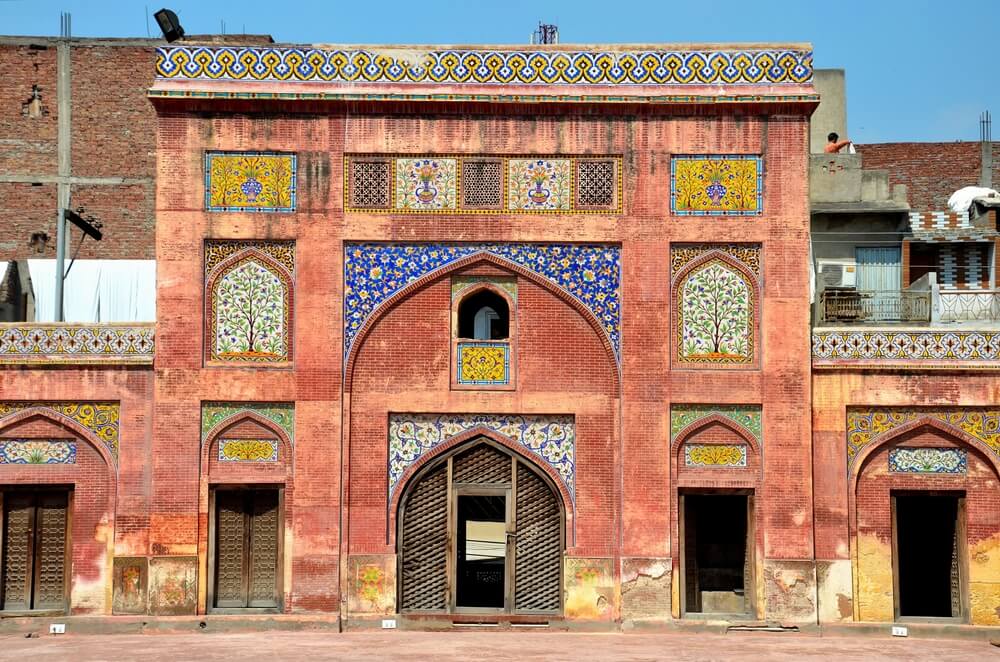
Holy Quran Verses and Persian Poetry
The facade of the entrance gateway facing Wazir Khan Chowk is adorned with intricate tilework and calligraphy, including Quranic phrases, sayings of the Prophet Muhammad (PBUH), and prayers for the Prophet (PBUH), as well as calligraphic emblems. According to historical texts, passages from Surah Al-Baqara of the Holy Quran were calligraphed by Haji Yousaf Kashmiri and hung over the main prayer hall’s entrance.
Wazir Khan Mosque’s interior walls are plastered and embellished with intricate fresco art, and you will undoubtedly become lost in the variety of designs and motifs. It is a photographer’s favorite, and you will see photographers whenever you visit the mosque.
Syed Muhammad Ishaq Gazuni Shrine
It was constructed around the tomb of the Iranian immigrant saint Syed Mohammad Ishaq Gazrooni, popularly known as the Miran Badshah, who died in the 13th century. According to historical records, construction of the mosque began in 1634 A.D., and even Emperor Shahjehan offered his Friday prayers at the Wazir Khan mosque.
Wazir Khan Mosque ticket price
There is no ticket fee to visit the Wazir Khan Mosque.
Wazir Khan Mosque timings
Wazir khan mosques are open from 5:00 AM to 8:00 PM
Location of the Wazir Khan Mosque
Address: Lahore, Punjab, 54000, Shahi Guzargah Dabbi Bazar, Chota Mufti Baqar Walled City of Lahore
Phone: +92-3027499547
Conclusions
The mosque includes some of the finest specimens of Mughal mosaic tilework, and students and academics worldwide undertake research there. The unique combination of calligraphy, geometrical and floral design distinguishes the Wazir Khan Mosque as a paragon of exquisiteness, beauty, equilibrium, and majesty. Consequently, you must visit this mosque if you are ever in Lahore.
You won’t regret it!
FAQs
Who built Wazir Khan Mosque in Lahore?
Hakeem IImud Din built this mosque in 1643.
Why Wazir Khan Mosque is famous?
Wazir Khan Mosque is noted for its complex faience tilework known as Kashi-Kari, and its interior surfaces are almost totally adorned with beautiful frescoes from the Mughal Empire.
Who is Wazir Khan?
Shaikh Ilam-ud-din Ansari (d. 1641), known by his royal title Wazir Khan, was a Chiniot native whose family settled in Lahore. He became one of the court physicians for the Mughal Emperor Shah Jahan at Lahore and was eventually named a Mughal noble after a long service career.
When was Wazir Khan Mosque built?
Wazir Khan Mosque was built in 1642.
Where is Wazir Khan Mosque located in Lahore?
Lahore, Punjab, 54000, Shahi Guzargah Dabbi Bazar, Chota Mufti Baqar Walled City of Lahore
